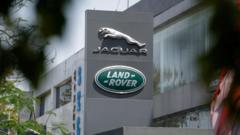Could US Trade Pause Be Hurting Jaguar Land Rover Sales?

Understanding the Sales Decline of Jaguar Land Rover: A Comprehensive Analysis
Jaguar Land Rover (JLR), a prominent player in the automotive industry, has recently reported a significant decline in sales, with a 15.1% drop observed over the three months leading to June. This downturn can be attributed to several factors, including the introduction of US tariffs, the planned phase-out of older Jaguar models, and the broader economic climate. This article delves into the various elements contributing to this decline, the implications for JLR, and the overall outlook for the future.
The Impact of Tariffs on Jaguar Land Rover's Sales
In April, the US government announced a new tariff plan that threatened to impose a 25% tariff on car imports, which directly impacted JLR. As a result, the Coventry-based manufacturer paused shipments to the US, leading to a significant decline in retail sales. The tariffs aimed to encourage domestic car production, creating a challenging environment for automotive producers that rely on exports.
Details of the Tariff Agreement
Fortunately, a subsequent agreement was reached between the US and UK governments, allowing JLR to resume exports in May. This deal introduced a reduced 10% tariff for the first 100,000 UK-manufactured cars imported into the US each year. However, any shipments beyond this threshold would be subjected to a hefty 27.5% tariff, effectively placing a cap on JLR's potential sales growth in the US market.
Sales Performance Analysis
JLR's retail sales fell by 94,420 units during the three months ending in June, with wholesale sales dropping by 10.7% to 87,286 units compared to the previous year. The company reported a 12.2% year-on-year decline in wholesale sales specifically in North America during the period when shipments were paused. Notably, the UK experienced an even steeper decline, with wholesale sales plummeting by 25%, largely due to the strategic decision to phase out older Jaguar models.
The Shift Towards Electric Models
One of the significant changes impacting JLR's sales strategy is the transition towards electric vehicles (EVs). The company halted the sale of new Jaguar cars in the UK late last year, focusing on the production of electric models set to launch in 2026. This pivot to EVs, while necessary for long-term sustainability, has created short-term challenges in sales performance.
Market Dynamics in the US
Historically, the US has been a vital market for JLR, with one in four of its cars exported to the country. Luxury and premium vehicles have particularly thrived in this market. Prof. David Bailey of Birmingham Business School notes that the US represents the second-largest market for the UK's automotive industry, trailing only the European Union. The tariffs and subsequent sales decline have raised concerns about the future viability of JLR's operations in this critical region.
Challenges Ahead for Jaguar Land Rover
As JLR navigates this tumultuous period, several challenges loom on the horizon:
- Consumer Sentiment: The ongoing economic uncertainty and rising inflation may dampen consumer confidence, leading to reduced demand for high-end vehicles.
- Supply Chain Issues: The global semiconductor shortage and other supply chain disruptions continue to pose risks, affecting production capabilities.
- Competition in the EV Market: As more automakers enter the electric vehicle space, JLR faces increased competition, making it essential to innovate and differentiate its offerings.
Strategies for Recovery
To overcome these challenges and regain its footing in the market, JLR may consider the following strategies:
1. Reinforcing Supply Chain Resilience
Enhancing supply chain resilience will be crucial for JLR. This may involve diversifying suppliers, investing in local production capabilities, and closely monitoring supply chain dynamics to mitigate risks.
2. Focusing on Electric Vehicle Development
JLR must prioritize the development and marketing of its upcoming electric models. By investing in innovative technologies, sustainable practices, and consumer education, the company can position itself as a leader in the EV market.
3. Strengthening Marketing Efforts
In light of the sales decline, JLR should ramp up marketing efforts to attract new customers and engage existing ones. Highlighting the unique features, luxury design, and sustainability credentials of their vehicles can help revitalize interest among consumers.
4. Exploring New Markets
To offset declining sales in traditional markets, JLR could explore opportunities in emerging markets. Expanding its footprint in regions like Southeast Asia or Africa could provide new revenue streams and bolster growth.
Conclusion
Jaguar Land Rover's recent sales decline is a multifaceted issue influenced by external factors such as tariffs and internal decisions to phase out older models in favor of electric vehicles. While the road ahead may be challenging, JLR has the potential to recover through strategic initiatives focused on innovation, consumer engagement, and market expansion. The automotive landscape is evolving rapidly, and how JLR navigates these changes will ultimately determine its success in the years to come.
Frequently Asked Questions
What caused Jaguar Land Rover's sales decline?
The sales decline can be attributed to the introduction of US tariffs, the planned wind-down of older Jaguar models, and broader economic challenges affecting consumer demand.
How have US tariffs impacted JLR?
The US tariffs on car imports led to a pause in shipments to the US, resulting in a significant decrease in retail and wholesale sales for JLR during the affected period.
What is JLR's strategy for future growth?
JLR's strategy includes focusing on electric vehicle development, reinforcing supply chain resilience, enhancing marketing efforts, and exploring new markets to offset declining sales.
As Jaguar Land Rover adapts to the evolving automotive landscape, how do you think the company can best position itself to thrive in the electric vehicle market? #JaguarLandRover #ElectricVehicles #AutomotiveIndustry
Published: 2025-07-08 07:01:13 | Category: technology



